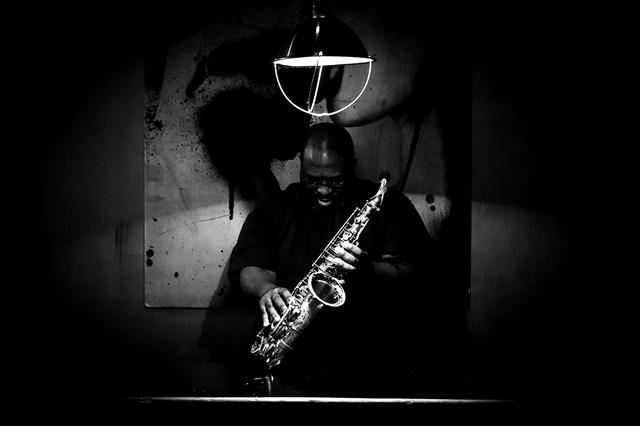
On the first night of a cold Halloweekend, Firehouse 12’s recording studio was rigged with seating for a few dozen people. The band’s stage was awash in crimson light. Up front, saxophonist Sam Newsome gently rearranged a few musical gizmos and percussion pieces.
He teased the tangles out of a windchime, letting loose the sound of a stiff June breeze blowing along the back porch of a ranch, singing through a jumble of wooden and metal tubes.
That was the scene—and sound—last weekend, as Firehouse 12 welcomed alto saxophonist Darius Jones to play from his new album Shades of Black, performed with musicians Michael Wimberly, Sam Newsome, Chad Taylor and Cooper Moore. Two back-to-back, sold-out crowds packed the space, warm and intimate even as temperatures dropped outside.
After a brief introduction, Jones sounded the opening notes of his track “Theory of Color.” Rocking a t-shirt that read “Dope&Carefree&Proud&Black,” he began a steady motif on his saxophone, joined by a sizzle from Wimberly’s gong. As Newsome harmonized his soprano with Jones’ tenor, Taylor’s drum rhythms and Moore’s keys filled in the low notes. After almost three minutes of repetition, Jones and Newsome shifted into a different motif that was more primitive and brief, cultivating a tension in the air with each revolution.
They segued into a disorienting groove. By the six minute mark, the pace of the hand drums and the kit had increased, and the ensemble sounded as if it was galloping. The music moved in great heaving waves that begged to break, and the audience writhed and clapped and murmured as the artists rode them. The sound awakened a spirit throughout the room, the crowd cheering at solos and moving in their seats with the mad advance of the music.
It was a chaotic ride, full of new moments and new feelings. Wimberly shifted from thrumming hand drum beats to idiosyncratic play of rattles and bells. Jones and Newsome returned to each of the earlier motifs. Organ, drums, and percussion all eventually coalesced to a persistent beat that brought the crowd down gently.
Speaking between songs, Jones said he’d been inspired to compose tracks on Shades of Black by Chiyu Uemae’s Untitled (1971), a vast expanse of textured and impregnable black oil paint. In these sounds there was the familiarity of a dark room and a soft bed, the tension and violence of shadowed paths and streets, the revelry at play behind closed doors and in sheltered groves.
There were more alien sounds too—the sounds of the things we do not know and have not yet met. It was as if the ensemble was creating a storm and attempting to weather it at the same time.
Jones flowed into his track “Optical Resolution,” the beginning of which is a groovy and steady bass rhythm, set to the low end of Moore’s organ and Taylor’s drumming. What began as a steady breeze was sundered by the sibilant sounds of the saxophones, the juxtaposition creating something deeply visual and corporeal.
Like a serpent sliding through the murk of a muddy path, vanishing in and out of sight but leaving an obvious trail, the woodwinds erupted with an intensity that demanded attention. Later in the piece, Moore took focus on the organ for a virtuosic and profound solo, which provoked Jones to give a goodnatured monkeyshine after the end of the song. Together, the two joked that they had just played some song of Moore’s invention.
“When I saw this painting, I saw there was so much movement in that stillness, like static,” Jones said of the painting after the piece. “What is in static? Does it move? Is it moving? Or is it still?”
“It was so black that it had colors in it,” he added. It was textural. And it was massive. When I experienced it, it was almost like I was walking inside of it. What would it sound like to stay in that space? To have music that just existed and that didn’t move from that energy.”
But Shades of Black revels in multiple artistic references. In “Color Out of Space,” the title of which is an overt reference to H.P. Lovecraft's prose poem of the same name, musicians set a confrontational and dissonant tone. Newsome frequently switched mouthpieces on his soprano saxophone between movements, letting him conjure up shrieks and hisses filled with mystery. The high tones of Moore’s organ entered the space like the warning tone of a machine or the chirrups of an alien toad. The whole piece lived in a world of uncharted constellations.
Like the pieces before it, “Color Out of Space” still explored what can happen when a motif is repeated and repeated. But it went deeper into a realm of syncopation and shadows. In a number of long segments, stillness and fullness were created not by the presence of sound but by the absence of it, and by the furtive or curious trilling and hissing and beating of one or two instruments at a time.
The musicians summoned alien cries. barks and stampings that were a near-revelry of Arthur Machen’s Great God Pan. After the second of two soft lulls in the piece, “Color Out of Space” revealed the stellar power Taylor has over a drum kit. The harmony between his playing and Wimberly’s percussion, as the horns and organ took a time of silence, created a system of tension that retained both levity and whimsy. It abruptly broke to peace as Jones, Newsome, and Moore closed the performance by sounding their instruments anew through the central motif.
“There’s something that happens when it’s rhythmically driven that changes the more you hear something,” Jones said later in the evening. “There’s something that happens to the listener and to us, there’s a physical aspect doing something over and over and over again, and it starts to become part of oneself, and you become a part of it.”

